#Cost Per Acquisition
Explore tagged Tumblr posts
Text
SEO vs PPC: Key Differences & When to Use Each
In the ever-evolving world of digital marketing, businesses face a critical decision: should they invest in Search Engine Optimization (SEO) or Pay-Per-Click (PPC) advertising? Both strategies offer unique advantages in driving online visibility and attracting potential customers. This comprehensive guide will explore the key differences, strengths, and strategic applications of SEO and PPC to…
#Click-through rates#Conversion rates#Cost per acquisition#digital marketing#Organic search rankings#Organic search results#Paid ads results#PPC#Return on ad spend#SEO
0 notes
Text
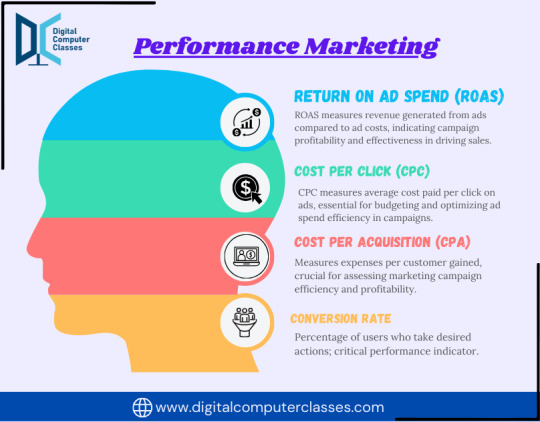
Performance Marketing Success: Key Metrics and Measurement Tips
Discover essential metrics like ROAS, CPA, and conversion rate to gauge performance marketing success effectively.
#Return on Investment#Conversion Rate#Cost Per Acquisition#Customer Lifetime Value#Click-Through Rate#Bounce Rate#Engagement Rate#Customer Retention Rate#Average Order Value#Return on Ad Spend
0 notes
Text
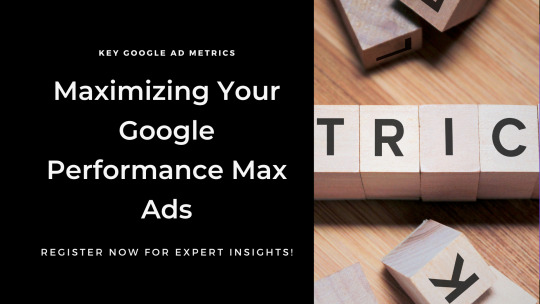
Maximizing Your Google Performance Max Ads: Key Metrics for Success
Google Performance Max Ads are a game-changer in the world of digital marketing, offering a streamlined way to manage and optimize your ad campaigns across multiple Google channels. But how do you know if your ads are truly effective? Understanding the right metrics to measure is crucial for gauging success and making informed decisions. In this blog post, we'll dive into the key metrics you should focus on to ensure your Google Performance Max Ads are hitting the mark.
Key Metrics for Measuring Google Performance Max Ads Success
Click-Through Rate (CTR)
CTR is the percentage of people who click on your ad after seeing it. It's calculated using the formula:
CTR=(TotalClicks/TotalImpressions)×100
A high CTR indicates that your ads are relevant and engaging to your audience. Monitor your CTR to assess the effectiveness of your ad copy and creatives.
Conversion Rate
Conversion rate measures the percentage of users who complete a desired action after clicking on your ad. The formula is:
ConversionRate=(TotalConversionsTotalClicks)×100
Tracking your conversion rate helps you understand how well your landing pages and overall sales funnel are performing.
Cost Per Click (CPC)
CPC indicates how much you are paying for each click on your ad. It's calculated as:
CPC=TotalCost/TotalClicks
A lower CPC can mean that your ads are well-targeted and efficient. It's a crucial metric for managing your advertising budget.
Cost Per Acquisition (CPA)
CPA measures the cost of acquiring a customer through your ads. The formula is:
CPA=TotalCost/TotalConversions
Monitoring CPA helps you evaluate the efficiency of your ad spend in generating conversions. Aim for a lower CPA to improve your return on investment (ROI).
Return on Ad Spend (ROAS)
ROAS is a critical metric for understanding the profitability of your ad campaigns. It’s calculated as:
ROAS=Revenue from Ads/Total Cost of Ads
A higher ROAS indicates that your ads are generating more revenue relative to their cost, signifying a successful campaign.
Impression Share
Impression share shows the percentage of total possible impressions your ad received. It's an indicator of your ad visibility and competitiveness:
ImpressionShare=(Impressions/TotalEligibleImpressions)×100
A high impression share suggests a strong market presence, while a low impression share may indicate the need for bid adjustments or improved ad relevance.
Advanced Metrics to Consider
Engagement Rate
Engagement rate goes beyond clicks to measure interactions with your ads, such as video views, likes, shares, or comments. This metric is particularly useful for video and display ads where engagement is a key performance indicator.
Quality Score
Quality Score is Google's rating of the relevance and quality of your keywords, ads, and landing pages. A higher Quality Score can lead to lower CPCs and better ad placements. Monitor this score to improve your ad performance.
View-Through Conversions
View-through conversions track the number of conversions that occurred after a user saw but did not click, your ad. This metric helps you understand the broader impact of your ad campaigns.
FAQs
What is a good CTR for Google Performance Max Ads? A good CTR varies by industry, but generally, a CTR above 2% is considered good. Monitor industry benchmarks to set realistic goals for your campaigns.
How can I improve my conversion rate? To improve your conversion rate, optimize your landing pages for relevance and ease of use, ensure your ad copy aligns with the landing page content, and test different calls to action.
Why is my CPC increasing? Your CPC may increase due to higher competition, lower Quality Scores, or broader targeting. Analyze your keyword bids, improve ad relevance, and refine your audience targeting to control costs.
How do I calculate my ROAS? Calculate your ROAS by dividing the revenue generated from your ads by the total cost of those ads. A higher ROAS indicates more profitable campaigns.
What affects my Impression Share? Impression Share can be affected by your ad bids, budget, ad relevance, and competition. Ensure your ads are highly relevant and consider adjusting your bids to improve visibility.
How often should I review my Performance Max Ads metrics? Review your metrics regularly—ideally weekly—to identify trends and make timely adjustments to your campaigns for optimal performance.
Conclusion
Monitoring the right metrics is essential for the success of your Google Performance Max Ads. By focusing on CTR, conversion rate, CPC, CPA, ROAS, and other key indicators, you can fine-tune your campaigns for maximum impact. Remember to review your metrics regularly and adjust your strategies based on the data to achieve the best results.
#performance marketing#ppc services#performance max#google ads#return on investment#cost per acquisition#conversion rate optimization#quality score
0 notes
Text

6 SUPER SIMPLE WAYS TO REMOVE WASTED GOOGLE AD SPEND & LOWER CPA
All you have to do is literally check a few boxes and radio buttons on the first five steps!
Do not let Google automatically apply ad suggestions.
Exclude your campaigns from showing up next to sensitive or negative content.
Exclude your ads from displaying among content that doesn’t fit your brand.
Properly adjust bidding on certain devices.
Make sure your location settings are targeting correctly.
Implement a click fraud software to detect and protect your budget.
Let's dive into each with examples and walk-throughs - https://www.tag-ad.com/6-super-simple-ways-to-remove-wasted-google-ad-spend-lower-cpa/
#ppc#pay per click#google ads#ad spend#ad budget#save money#reduce waste#lower cpa#cost per acquisition
0 notes
Text

Regardless of what business or industry you are in, the Cost per Acquisition (CPA) is how much you spend in sales and marketing combined, to acquire a new customer. The pursuit of an effective CPA is perhaps one of the most important challenges you and your business will go through. There are many digital marketing agency, that provides effective techniques to boost your CPA.
0 notes
Link
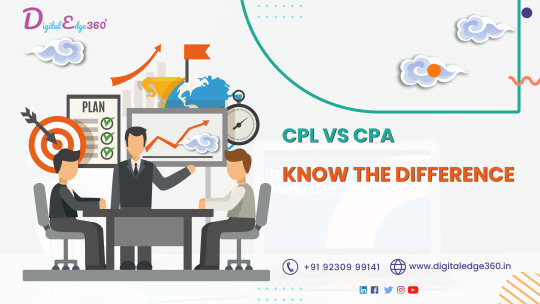
Marketers have this habit of finding acronyms to describe the cost of something. For example, we have come across CPM (cost per mile), CPC (cost per click), CPL (cost per lead), and CPA (cost per acquisition).
We have come across various performance marketing agencies responsible for their clients’ paid media or their own paid campaigns.
Here is a descriptive blog on CPL vs CPA elaborating the difference between them. Let’s dig in!!!
#cost per lead#cost per acquisition#CPL#CPA#performance marketing#social media marketing#search engine marketing#google ads#social ads#digital edge 360
1 note
·
View note
Text
AAA games targeting a release date of 2024-2025 mostly have budgets of 200 million dollars or more. Do you know how many fucking copies you have to sell of a game to even break even with that?? That's why AAA studios only make games with the broadest possible mass market appeal! They can't afford to do anything else!
#Apparently five years ago budgets for a triple a were more in the range of 50-150 million dollars but costs went up rapidly#And call of duty seems to have a budget of around 300 million per game which is wild#Anyway this info is from the UK CMA report about blocking Microsoft's acquisition of blizzard-activision#If you want to check it out yourself#This totally derailed me from what I was originally going to post about these numbers are just crazy#Anyway yeah. Why are games Like That? Well at those prices they have to be#Indies cost (relatively) less to make and can therefore take more risks#What an absurd amount of money
14 notes
·
View notes
Text
Wholeheartedness, Part 2: Flinch-Elimination
Long ago, being in the presence of wasps made me very nervous. What if they stung me? The swelling would be uncomfortable, and the pain would be inconveniently distracting! This would be a bad outcome; I wanted to avoid it. Thus I would, whenever I noticed a wasp near me, stand still until it went away.
This habit caused me more inconvenience than the two wasp stings I'd received in my life up to that point ever did.
Once I noticed this, I decided: fine. Let's just go get stung by more wasps, then, until I'm inured to it and no longer freeze up when wasps are near.
And thus, having resolved this, I no longer had any need to fear the attacks of wasps. If I were to walk at full speed near one, and it were to respond by stinging me, this would be a step forward along the path to inurement, which would be an acceptable thing to gain in return for the cost in discomfort and inconvenience.
It's an old story. (One I've told before, even.) But the relevant principles don't end with wasp stings.
Currently, I do my web searches via a paid subscription service, rather than free via Google; the results are better, and with how much web-searching I do and how much money I have to spare it's a pretty solidly worthwhile deal. But they offer only a limited number of searches per month complementary with the subscription; if one exceeds that number of searches in a month—200, at my current subscription tier—one will need to either stop searching for the rest of the month or start paying 1.5 cents per search. And when I first subscribed I got very flinchy about trying not to search too much, out of fear of that extra charge. Because 1.5 cents is a cost, and surely I'd rather avoid paying that cost on any given search if I don't have to, right?
But, of course, making substantially less use of web search would be a much larger cost than an extra few dollars a month. (I am, after all, paying them money specifically for the sake of getting more out of my web-searching; searching less would run actively counter to the reasons I subscribe at all.) So I did the natural thing: I decided to deliberately search profligately until I broke the 200-search ceiling and started paying additional marginal money per search, for a couple months, until inured to that experience. It's been going great so far: I haven't yet hit the ceiling, but I sure am no longer flinching away from the searches I want to make.
Or, for a third example, this time one where I actually succeeded in exposing myself to more of the flinch-inducing thing: water bills. I used to flinch away from drinking water, because I knew it'd add on the margins to my house's water bills. This was doing me more harm than good. So I took a few extra baths, compared with what I'd otherwise have taken—together summing up to an amount of water-use that my drinking rates would have taken weeks or months to sum up to, since a bathtub's worth of water is in fact A Lot—and I observed that no great financial disaster ensued as a result, and that was the end of my flinching-from-drinking-water.
Backing off and generalizing, now: sometimes, there are inconveniences whose possibility I flinch from, where the flinches cost far more than the cost of just enduring the inconveniences occasionally. And, under those circumstances, it can often be useful to deliberately overcompensate against the flinch response. To try, not just to suppress the flinch response in each individual instance (which tends to be an attention-demanding and difficult process), but to actively toss myself at the flinch-inducing thing until I'm so thoroughly inured to it that it ceases to produce flinch-responses-in-need-of-suppression in the first place. As long as I'm tossing myself in that direction, the tossing overrides the flinch response. Once I've succeeded sufficiently in the tossing, inurement will override the flinch response. And thus the mental overhead of needing to suppress the response will be eliminated, to my benefit as long as I was correct in my choice of what flinch response to get rid of in the first place.
Because intuitively-appealing steps to avoiding inconveniences can be more inconvenient than the inconveniences being avoided, sometimes. And it's valuable, when that happens, to be able to just stop avoiding them.
#Archive#Self-Improvement#Wholeheartedness#of course this is really a continuum rather than a binary#i no longer avoid stings from individual wasps but i still wouldn't want to get stung by dozens in quick succession#because unlike single stings i expect that that would be more inconvenient than avoiding it is!#so there's an element of careful targeting in exactly which experiences one throws oneself at for inurement-acquisition purposes#(of course as per the prior post there are only finite costs it's worth paying to get one's targeting right)#(as long as one can aim *well enough* even if some of one's moves are wrong it's still better to move more rather than less)
35 notes
·
View notes
Text
A Real-World Example of PPC Marketing Strategies
New blog! Let's create a real-world example to show how businesses utilize PPC marketing and SEO to connect consumers and what they search for with what marketers are looking to promote.
by Kimberly Eugene, 05/04/2023 Photo by Pixabay on Pexels.com Search engine marketing (SEM) and search engine optimization (SEO) tools are being used increasingly by marketers to reach their customers due to their ability to connect consumers to what they search for with what marketers are looking to promote. The two main tactics within SEM are pay-per-click (PPC) advertising and SEO, and…

View On WordPress
#ads#Adwords#bidding strategy#bounce rate#click-through rate#content marketing#conversion rate#conversions#cost-per-acquisition#cost-per-mille#CPA#CPM#CTR#CVR#digital marketing#Google Ads#Google Ads preview tool#Google Analytics#keyword research#keywords#Kimberly Eugene#marketing#negative keywords#pay-per-click#PPC#PPC Marketing#PRTYNVRNDS LLC#real world example#return on investment#ROI
3 notes
·
View notes
Text
How to Effectively Merge PPC and SEO Without Overspending?
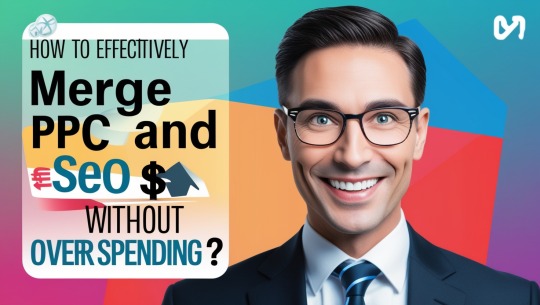
I never thought I'd crack the code of online marketing. My small business was struggling, lost in the vast digital landscape.
Then it hit me - why not combine PPC and SEO?
Day one, I started researching. Google Ads became my new best friend.
I crafted compelling ad copy, targeting keywords like "affordable local services" and "best [my industry] near me". Simultaneously, I optimized my website for these same phrases.
The results? Shocking. Within a week, my click-through rate jumped by 35%. But here's the kicker - my organic traffic also surged by 20%. The synergy was real.
I dug deeper. Analyzing my PPC data, I discovered long-tail keywords I'd never considered. "24/7 emergency [my service] in [my city]" became a goldmine. I incorporated these into my content strategy, creating blog posts and landing pages.
Suddenly, I was ranking for terms I'd never dreamed of.
My bounce rate plummeted from 65% to 40%. People were finding exactly what they needed.
But it wasn't all smooth sailing. My ad spend initially skyrocketed. Panic set in. Was I hemorrhaging money?
That's when I had my eureka moment.
I used my SEO insights to refine my PPC strategy.
By focusing on high-converting organic keywords, I slashed my cost-per-click by 25%.
Now, my website is a powerhouse. Organic traffic feeds my remarketing campaigns. PPC data informs my content creation. It's a beautiful, cost-effective cycle.
The result? My online visibility has doubled. Sales are up 50% year-over-year. And the best part? My marketing budget hasn't increased a dime.
What strategies have you used to integrate PPC and SEO? Share your experiences in the comments!
Get Tips, Suggestions, & Workarounds, in 2-3 mins, on How to Effectively Merge PPC and SEO Without Overspending?
#ppc#seo#digital marketing#online visibility#keyword research#ad copy#content strategy#remarketing#cost-per-click#organic traffic#conversion rate#landing pages#google ads#long-tail keywords#marketing budget#website optimization#click-through rate#bounce rate#search engine rankings#paid advertising#organic search#target audience#ROI#analytics#competitive advantage#marketing ROI#brand awareness#customer acquisition#lead generation#SubhamDas
0 notes
Text
CPA Calculator
A CPA Calculator is a convenient tool that simplifies the process of calculating cost per acquisition. By inputting several key marketing metrics, such as total ad spend and the number of new customers acquired, they can swiftly compute the CPA. It’s designed to help businesses and advertisement professionals get quick insights into the effectiveness and efficiency of their marketing campaigns. This data helps them make informed budgeting decisions and identify optimization opportunities.
0 notes
Text
What is Google Display Ads?
Google Display Ads are a type of online advertising that appear on websites, apps, and social media platforms within Google's vast Display Network. Unlike search ads, which are text-based and appear on search engine results pages (SERPs), display ads are visual advertisements in the form of images, videos, or interactive media.
These ads can target specific demographics, interests, or behaviors of internet users, allowing advertisers to reach their target audience effectively. Google Display Ads can be created and managed through Google Ads, where advertisers can design their ads, set targeting options, and manage their budget.
The Display Network encompasses millions of websites, blogs, news pages, and Google-owned platforms like YouTube and Gmail, providing advertisers with extensive reach and the ability to showcase their products or services to a broad audience across the internet.
Google ads free Course >>> https://www.youtube.com/channel/UCL0h9-P642Hze6IQMvZaUsQ
Hire Google ads Expert >>> https://rafiqmia.com/
#GoogleAds#PPC#OnlineAdvertising#DigitalMarketing#SEM (Search Engine Marketing)#DisplayAds#AdWords#PPCMarketing#GoogleAdsTips#GoogleAdsCampaign#AdCampaign#AdWordsOptimization#PaidSearch#ROI (Return on Investment)#CTR (Click-Through Rate)#CPA (Cost Per Acquisition)#ConversionTracking#Remarketing#KeywordResearch#AdCopy
0 notes
Text
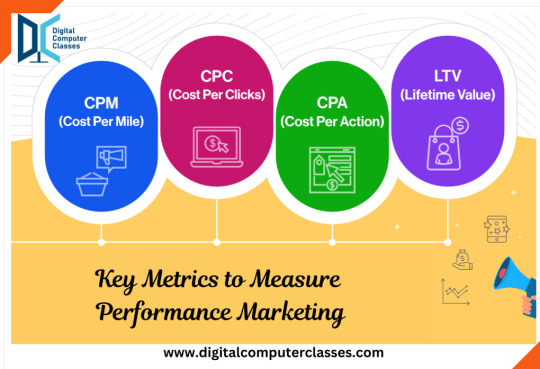
#Return on Investment#Conversion Rate#Cost Per Acquisition#Customer Lifetime Value#Click-Through Rate#Bounce Rate#Engagement Rate#Customer Retention Rate#Average Order Value#Return on Ad Spend
0 notes
Text
5 Data-Driven Tips to Improve Retail Cost Per Acquisition (CPA)

Improving Cost per Acquisition (CPA) is critical for long-term success in retail's cutthroat environment. Retailers may improve their advertising and sales results by using data-driven methods. This article will provide five helpful hints for enhancing retail CPA using data-driven decision making.
1. Define Your Target Audience:
Successful advertising efforts begin with careful research on the demographics of the intended recipient. Learn more about your clientele's habits, tastes, and demographics by analyzing the information you already have. Targeted tactics that speak directly to your ideal clients may be developed with the help of customer segmentation and personas.
2. Leverage Predictive Analytics:
Revolutionize your retail marketing with the power of predictive analytics. Unleash the power of historical data to reveal valuable insights and patterns that enable you to anticipate customer behavior and preferences. Experience the power of personalized marketing campaigns that are tailored to your individual customers. With predictive analytics, you can optimize your ad targeting, channel selection, and offer customization.
3. Implement A/B Testing:
Discover the ultimate marketing campaign by conducting A/B testing, where two versions are pitted against each other to determine the superior performer. Discover the winning combination of ad copy, visuals, calls-to-action, and landing pages by conducting tests on various variables and analyzing the resulting data. With A/B testing, you can make informed decisions based on data, optimizing your marketing campaigns and boosting your ROI by investing in high-converting strategies.
4. Utilize Retargeting
The utilization of customer data to target potential customers who have previously displayed interest in a company's products or visited their website is a potent marketing strategy known as retargeting. Through the monitoring of user actions and the implementation of customized advertisements on various channels, it is possible to prompt and incentivize consumers to finalize their transactions.
5. Optimize Landing Pages and Conversion Funnels
If you want to lower your cost per acquisition, you need a landing page and conversion funnel that work. Look at the numbers and see where the customers are getting stuck so you can fix it. You may enhance user experience and conversion rates by experimenting with various layouts, messages, and call-to-action placement. Achieve maximizing conversions and decreasing cost per acquisition by constant testing and tweaking of landing pages and conversion pathways.
Let's consider 2 scenarios:
Company A and Company B, retail enterprises, each spent $30,000 on marketing. Both firms sought 15,000 customers. Company A optimized their CPA using data, but Company B did not.
Data-Driven Approach
Company A optimized campaigns through A/B testing and retargeting. Thus, their target audience converted 8%.
Company B did not segment, test, or retarget customers. Thus, their target audience converted 4%.
Calculated CPA based on given data:
CPA of Company A= ($30000/(0.08*15000)
= $25
CPA of Company B= ($30000/(0.04*150000)
= $50
Analysis
Company A, which used data-driven methods, had a $25 CPA, whereas Company B had a $50 CPA. Data-driven decision making improves CPA and lowers marketing expenses.
Conclusion:
An analytics- and data-driven strategy is needed to increase retail CPA. Efficient marketing campaigns, lower CPA, and long-term success are all within reach for retailers if they take the time to identify their target demographic, use predictive analytics, implement A/B testing, employ retargeting, and optimize landing pages and conversion funnels.
#cost per acquisition#audience targeting#a/b testing#retargeting#predictiveanalytics#performance marketing#landingpage#landing page optimization#conversion rate optimization#historical data
0 notes
Text
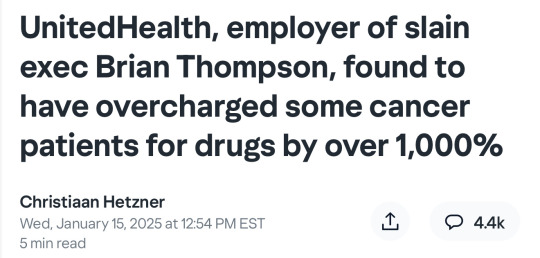


UnitedHealth Group is charging patients a markup for key life-saving drugs that could easily exceed their cost by a factor of ten or more, according to findings from the Federal Trade Commission.
The report, which levels the same allegations at CVS and Cigna, is the latest indictment of America’s broken healthcare system and comes on the heels of last month’s shocking murder of UnitedHealthcare CEO Brian Thompson.
The U.S. is notorious for incurring the highest costs per capita of any wealthy nation, yet failing to achieve an even remotely equivalent improvement in patient outcomes versus Europe’s social market-based economies.
Critics argue that is due largely to the highly opaque manner in which needless markups are hidden to conceal inefficiencies that serve various vested interests. These include, but are not limited to, the big three drug middlemen known as pharmacy benefit managers (PBMs).
According to the FTC report, UnitedHealth’s OptumRx, along with Cigna’s Express Scripts and CVS Caremark Rx, were able to collectively pocket $7.3 billion in added revenue above cost during the five year period of the study through 2022.
“The Big 3 PBMs marked up numerous specialty generic drugs dispensed at their affiliated pharmacies by thousands of percent, and many others by hundreds of percent,” it concluded.
A thousand percent increase in the price of a drug that costs $10 wholesale would result in a retail price of $110.
This markup rate applied to 22% of the specialty therapies examined, including Imatinib, a generic used to treat leukemia, or non-oncological Tadalafil for pulmonary hypertension. Others such as Lamivudine needed by HIV-positive patients were nearly quadruple the price of their acquisition cost.
Independent Vermont Sen. Bernie Sanders has been conducting Congressional hearings in an attempt to shed light on the problems posed by these drug middlemen as well as drugmakers themselves.
(continue reading)
#politics#healthcare#united healthcare#luigi mangione#brian thompson#insurance#price gouging#capitalism#ftc#lina khan#oncology#profitized healthcare#privatized healthcare#corporate greed#cvs#cigna#pharmacy benefits managers
432 notes
·
View notes
Text

Homebrew Mechanic: Fixing D&D’s Gameplay Loop with Item Degradation
Normally I have snappy titles for these, but in this case I wanted to be super upfront with what I was getting you all into.
Some people are not going to like the idea of introducing item degradation into the game, and they’re ABSOLUTELY right to be hesitant. Just about every attempt I’ve seen (includig both RAW versions from previous editions, examples from videogames, and those I’ve put together myself in the past) have been horribly clunky exercises in beancounting that only ever existed to needlessly slow down gameplay for the sake of joyless realism.
I’ve come at it from another angle however, but to explain we’re going to need to get into some game design talk.
The basic gameplay loop of D&D is supposed to be:
Seeking adventure leads you to face challenges
Overcoming challenges leads you to rewards
Rewards Help you get stronger
Getting stronger allows you to seek tougher adventures
After a while this system starts to break down specifically with regards to gold as a method of reward. Even if you’re the smart sort of DM who flouts the rules and gives their party access to a magic item shop, there’s an increasingly limited number of things to spend gold on, leading to parties acquiring sizable hordes of riches early on in their adventuring career, completely eliminating the desire to accept quests that pay out in gold in one form or another. This is a pretty significant flaw because adventures that centre around acquisition of riches ( treasure hunts, bounty missions, busywork for rich patrons that will inevitably betray you) are foundational to storytelling within the game, especially early on in a campaign before the party has gotten emotionally invested. Most advice you can find online attempting to solve this problem tends to dissolve down to “let them pour money into a home base”, but that can only really happen once per campaign as a party is unlikely to want more than one secret clubhouse.
TLDR: What I propose is the implantation of a lightweight system that forces the party to periodically drop small amounts of wealth into maintaining their weapons/armour/foci. The players will be motivated to seek out gold in order to keep using their best stuff, giving value to treasure drops that previously lacked it. Not only does this system act as an insulation against powercreep at higher levels, it also encourages a party to engage with the world as they seek out workshops and crafters capable of repairing their gear.
The System:
Weapons, armour, shields, and caster foci (staves, holy symbols etc) can accumulate “ticks” of damage, represented by a dot or X drawn next to their item entry on the character sheet. Because you get better at handling your gear as you level up, an item that exceeds a total number of ticks equal to its bearer’s proficiency bonus breaks, and is considered unusable until it is repaired.
Weapons and Foci gain a tick of damage when you roll a natural 1 on an attack made with them, or if they are specifically targeted by an enemy’s attack.
Armour and shields gain a tick of damage when you roll a nat 1 on a saving throw or when an enemy beats your ac by 5 or more. A character equipped with both can decide which of the two items receives the tick
Creatures with the “siege” (or any “does double damage to objects” ability) deal an extra tick when attacking gear.
A character with a crafting proficiency and access to tools can repair a number of ticks of damage equal to their proficiency on a four hour work period. This rate is doubled if they have access to a properly equipped workshop. A character with access to the mending cantrip can repair ticks on any kind of item, but is limited to their proficiency bonus per work period.
Having an item repaired by an NPC crafter removes all ticks, but costs vary depending on the rarity of the item: 5g for a mundane item, 10g for a common item, 50g for uncommon, 250 for a rare, 1250 for a very rare, 6250 for a legendary. The DM decides the limit on what each crafter can repair, as it’s likely small towns have access to artisans of only common or uncommon skill, requiring the party to venture to new lands or even across planes if they wish to repair end game gear.
As you can see, degradation in this system is easy to keep track of and quite gradual, leading players into a position where they can ignore obvious damage to their kit for the sake of saving their now precious gold. It likewise encourages them to seek out NPC crafters (and potential questhooks) for skills they do not possess, and encourages the use of secondary weapons either as backups or to save the more potent items in the arsenal for a real challenge.
Consumables
Everyone knows the old joke about players hoarding consumables from the first adventure past the final bossfight, it transcends genre and platform, and speaks to a nature of loss aversion within our shared humanity. However, giving players items they’re never going to use amounts to wasted time, resources, and potential when looking at things from a game design perspective, so lets work on fixing that.
My inspiration came from witcher 3, which encourages players to make frequent use of consumables by refreshing them whenever the character had downtime. The darksouls series has a similar feature with the signature estus flask, which provides a limited number of heals before it must be refreshed at one of the game’s checkpoints. When the designers removed the risk of permanent loss and the anxiety it creatures, players were able to think tactically about the use of their consumables confident in the knowledge that any mistakes were just a resupply away from being fixed.
My proposal is that while the party is in town they can refill the majority of their consumable items for a small per item fee. Just like with gear degradation, this encourages them to seek out crafters and do quests for the hope of discounts, while at the same time encouraging them to explore new realms in the hope of discovering higher level artisans.
The price for refills is set at: 5g for common, 25g for an uncommon, 125g for a rare, 625g for a very rare, 3125g for legendary. I encourage my own players to keep a “shopping list” in their inventory with prices tabulated so they can hand out a lump sum of gold and have their kit entirely refreshed.
Characters with a relevant skill and access to their tools can refill a number of items equal to their proficiency bonus during a four hour work period. With access to a proper workshop, this rate doubles. ( At last, proficiency with brewers supplies, carpenters tools etc become useful)
I encourage you as a DM to check out this potion flasks system, which I’ve found adds a delicious factor of uncertainty back into the mix. Attached is also my super lightweight rules for tracking gear and supplies, which I absolutely refuse to shut up about.
Artist
217 notes
·
View notes